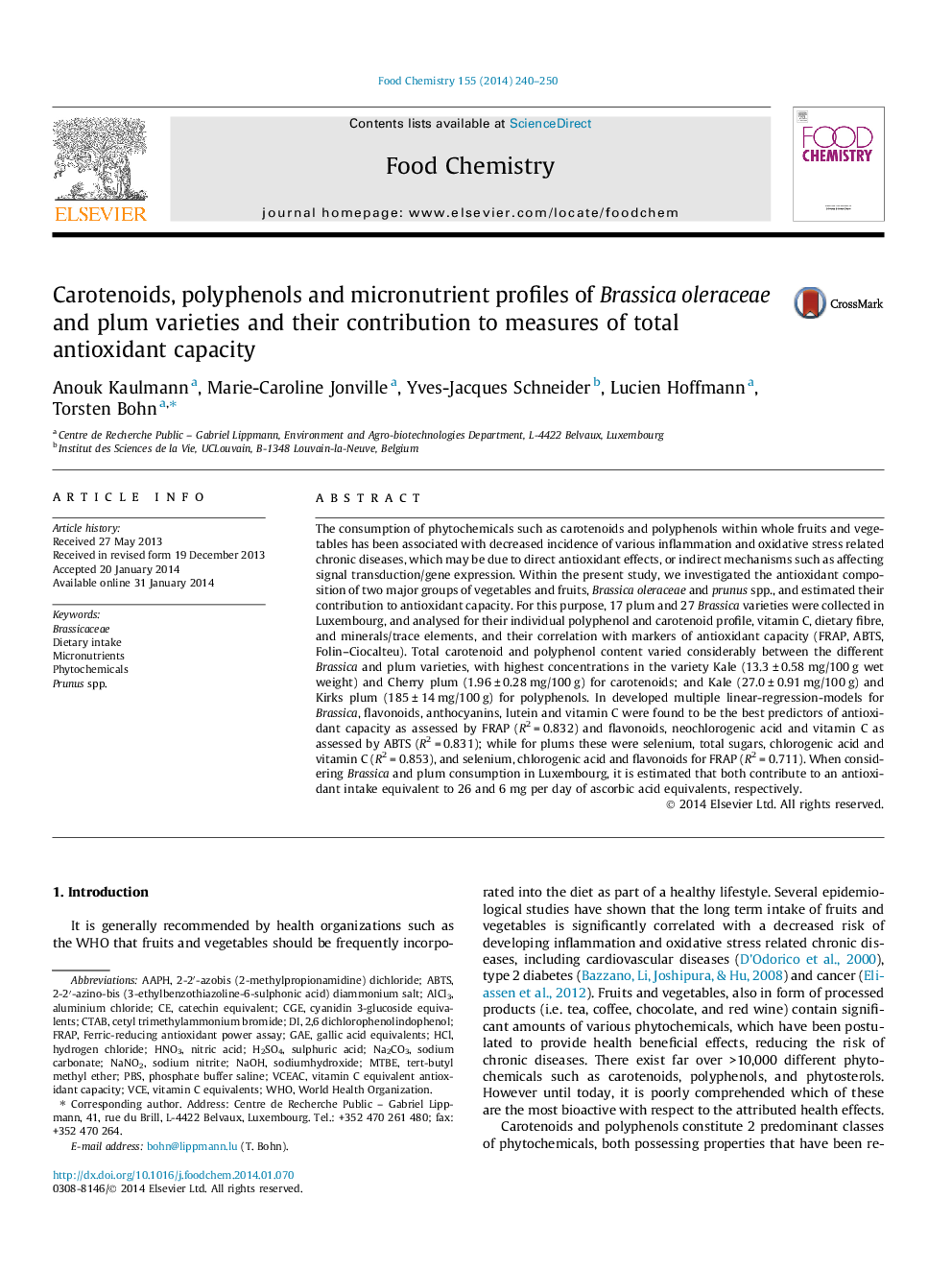| کد مقاله | کد نشریه | سال انتشار | مقاله انگلیسی | نسخه تمام متن |
|---|---|---|---|---|
| 7598403 | 1492136 | 2014 | 11 صفحه PDF | دانلود رایگان |
عنوان انگلیسی مقاله ISI
Carotenoids, polyphenols and micronutrient profiles of Brassica oleraceae and plum varieties and their contribution to measures of total antioxidant capacity
دانلود مقاله + سفارش ترجمه
دانلود مقاله ISI انگلیسی
رایگان برای ایرانیان
کلمات کلیدی
H2SO4Prunus spp.GAEMTBEFRAPAAPHCGEAlCl3VCEABTSNaOHNaNO2HClHNO3CTABNa2CO3PBSBrassicaceae - خانواده شب بو شب بوها یا چلیپائیانcetyl trimethylammonium bromide - استاتیم ترتیل آمونیوم برومیدsulphuric acid - اسید سولفوریکgallic acid equivalents - اسید گالیک اسید معادلtert-butyl methyl ether - تربت بوتیل متیل اترWorld Health Organization - سازمان بهداشت جهانیphosphate buffer saline - فسفات بافر شورPhytochemicals - فیتوکمیکال هاDietary intake - مصرف غذا catechin equivalent - معادل کاتچینMicronutrients - میکرونوترینت هاSodium nitrite - نیتریت سدیمNitric acid - نیتریک اسید، اسید نیتریک Sodium carbonate - کربنات سدیمAluminium chloride - کلرید آلومینیومHydrogen chloride - کلرید هیدروژنWHO - که
موضوعات مرتبط
مهندسی و علوم پایه
شیمی
شیمی آنالیزی یا شیمی تجزیه
پیش نمایش صفحه اول مقاله

چکیده انگلیسی
The consumption of phytochemicals such as carotenoids and polyphenols within whole fruits and vegetables has been associated with decreased incidence of various inflammation and oxidative stress related chronic diseases, which may be due to direct antioxidant effects, or indirect mechanisms such as affecting signal transduction/gene expression. Within the present study, we investigated the antioxidant composition of two major groups of vegetables and fruits, Brassica oleraceae and prunus spp., and estimated their contribution to antioxidant capacity. For this purpose, 17 plum and 27 Brassica varieties were collected in Luxembourg, and analysed for their individual polyphenol and carotenoid profile, vitamin C, dietary fibre, and minerals/trace elements, and their correlation with markers of antioxidant capacity (FRAP, ABTS, Folin-Ciocalteu). Total carotenoid and polyphenol content varied considerably between the different Brassica and plum varieties, with highest concentrations in the variety Kale (13.3 ± 0.58 mg/100 g wet weight) and Cherry plum (1.96 ± 0.28 mg/100 g) for carotenoids; and Kale (27.0 ± 0.91 mg/100 g) and Kirks plum (185 ± 14 mg/100 g) for polyphenols. In developed multiple linear-regression-models for Brassica, flavonoids, anthocyanins, lutein and vitamin C were found to be the best predictors of antioxidant capacity as assessed by FRAP (R2 = 0.832) and flavonoids, neochlorogenic acid and vitamin C as assessed by ABTS (R2 = 0.831); while for plums these were selenium, total sugars, chlorogenic acid and vitamin C (R2 = 0.853), and selenium, chlorogenic acid and flavonoids for FRAP (R2 = 0.711). When considering Brassica and plum consumption in Luxembourg, it is estimated that both contribute to an antioxidant intake equivalent to 26 and 6 mg per day of ascorbic acid equivalents, respectively.
ناشر
Database: Elsevier - ScienceDirect (ساینس دایرکت)
Journal: Food Chemistry - Volume 155, 15 July 2014, Pages 240-250
Journal: Food Chemistry - Volume 155, 15 July 2014, Pages 240-250
نویسندگان
Anouk Kaulmann, Marie-Caroline Jonville, Yves-Jacques Schneider, Lucien Hoffmann, Torsten Bohn,